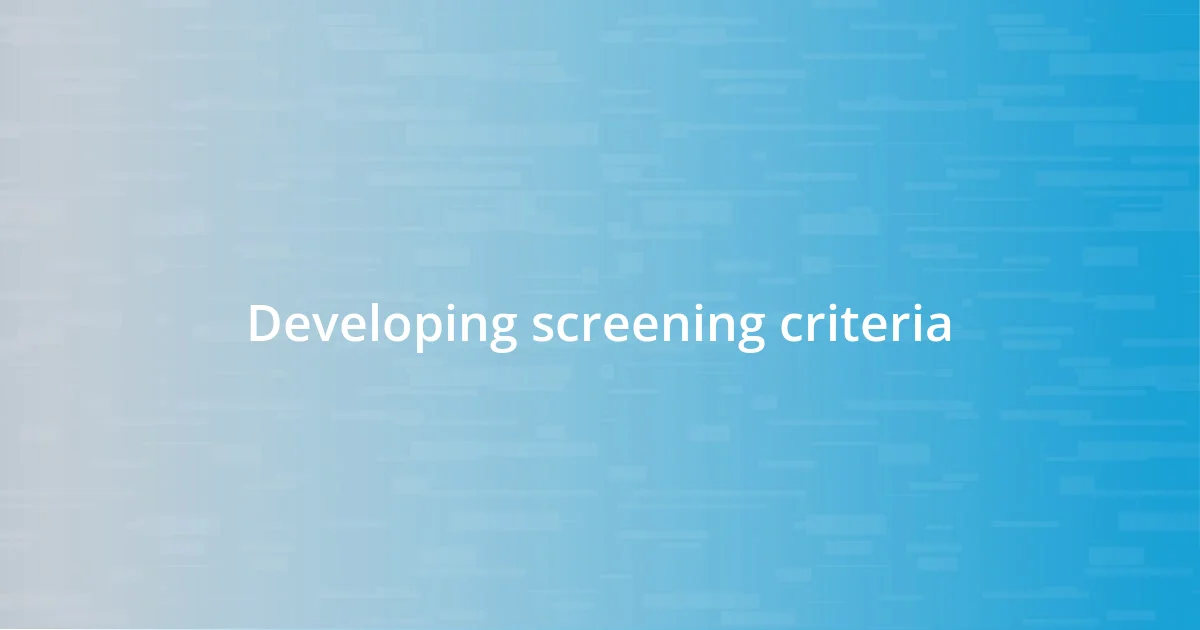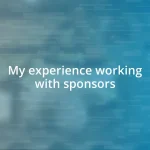Key takeaways:
- Developing a comprehensive screening strategy involves blending quantitative and qualitative factors, aligning goals with personal values, and maintaining flexibility.
- Engaging with stakeholders and gathering feedback throughout the screening process enhances understanding of target groups and fosters a sense of community.
- Evaluating outcomes requires deep analysis of both data and participant feedback, highlighting the importance of continual reflection and adaptability to achieve meaningful impact.

Understanding screening strategies
When I first started exploring screening strategies, I realized they’re not just about the numbers; they’re a blueprint for identifying what truly matters. I often found myself asking, “What if I miss the perfect opportunity because I overlooked a critical detail?” This fear pushed me to develop a nuanced approach, blending both quantitative and qualitative factors.
Diving deeper into this, I discovered that an effective screening strategy should align with specific goals. For instance, in one project, I tailored my criteria to not only focus on financial metrics but also consider cultural fit and potential for long-term growth. This holistic view allowed me to pursue opportunities that resonated on multiple levels, enriching my decision-making process.
At times, the complexity of screening can feel overwhelming, like trying to find a needle in a haystack. However, I learned that breaking the process into manageable steps—defining clear goals and prioritizing essential criteria—simplified my approach. Have you ever felt lost in a sea of options? By narrowing my focus and refining my strategy, I began to see the wood for the trees, making informed decisions that truly aligned with my vision.

Identifying screening goals
Identifying screening goals is a pivotal step in shaping an effective strategy. I remember when I first had to establish my objectives for a new project; I sat down with a cup of coffee and a blank sheet of paper. It was enlightening to realize that my goals weren’t just financial; I needed to consider my values, the impact on the community, and the potential growth. This moment of clarity helped me align my ambitions with my personal and professional values.
As I refined my goals, I started to differentiate between short-term and long-term objectives. For example, while increasing immediate revenue was essential, I also aimed to cultivate relationships that would offer support far into the future. I often ask myself, “What legacy do I want to leave?” This question guides my intentions and ultimately enriches the screening process. It’s like setting a compass that points toward my desired future.
The importance of specificity in goals cannot be overstated. Initially, I was too vague in my objectives, which led to scattered results. However, once I began articulating my goals with precision, I noticed a shift. It’s akin to tuning an instrument; the more I focused, the more harmonious my decisions became. By so doing, I discovered opportunities I would have previously missed—sometimes even right under my nose.
| Type of Goal | Description |
|---|---|
| Short-term | Immediate financial gains and quick results. |
| Long-term | Sustainable growth and fostering impactful relationships. |
| Personal | Alignment with values and community impact. |

Researching best practices
Researching best practices for screening strategies led me down a fascinating path. I remember poring over countless articles and case studies, driven by a blend of curiosity and necessity. It was like piecing together a puzzle; every new piece of information helped me see the bigger picture. What struck me most was how often the significance of community input surfaced. Engaging with others in my field opened my eyes to diverse perspectives that I hadn’t considered before.
Here’s what I found most useful during my research:
- Industry Benchmarking: Reviewing successful strategies in similar sectors helped me identify common themes.
- Peer Collaborations: Connecting with colleagues allowed for shared experiences and tips that felt applicable.
- Stay Updated: Subscribing to industry newsletters ensured I was aware of emerging trends and evolving practices.
- Feedback Loops: Establishing a routine for soliciting feedback from stakeholders created a dynamic learning environment.
- Trial and Error: Embracing experimentation informed my understanding of what really worked for my specific context.
Eventually, these insights formed the backbone of my screening strategy, empowering me to navigate challenges with confidence. It was a gratifying experience, reminiscent of unearthing hidden treasures that aligned perfectly with my vision.

Analyzing target groups
Analyzing target groups requires a nuanced approach I came to appreciate through years of experience. When I first started, I quickly learned that demographics alone don’t tell the whole story. I remember attending a workshop where a speaker highlighted the importance of psychographics—the values, interests, and lifestyles of individuals. This revelation made me rethink my strategy altogether. Now, when I think about a target group, I ask myself: “Who are they at their core?” Understanding these deeper layers allows me to connect with them on a meaningful level.
I also rely on data analytics to shape my understanding of target groups. The first time I dived into audience segmentation, it was like unlocking a treasure chest of insights. For instance, I discovered that certain audiences preferred informative content while others engaged more with storytelling. By analyzing this data, I can tailor my approach, ensuring that my messages resonate. It’s a process I’ve grown to enjoy; each data point brings me closer to crafting a compelling narrative around my screening efforts.
Feedback from initial screenings has been instrumental in refining my understanding of target groups. One memorable instance was when I piloted a screening process and gathered input from participants afterward. To my surprise, their insights differed significantly from my assumptions. This experience taught me that ongoing evaluation and adaptability are crucial. I now frequently ask myself, “How can I better align with my audience’s needs?” Embracing this mindset not only enhances my strategy but also fosters a sense of community.

Developing screening criteria
When it comes to developing screening criteria, I found that clarity is paramount. Initially, I grappled with that ebb and flow of ideas; it was a bit chaotic. I vividly recall sitting at my kitchen table, surrounded by sticky notes, trying to figure out what truly mattered in this process. I thought, “What are the non-negotiables?” This simple question helped ground my criteria, ensuring they were practical and relevant.
One of my epiphanies came from collaborating with a former colleague who emphasized the importance of balancing both qualitative and quantitative factors. It was eye-opening! I remember we used a whiteboard to list out possible criteria, mixing hard data with more subjective insights like emotional readiness. That blend created a more holistic approach that truly resonated with our target audience. The moment I realized that both sides were needed—it was like the lights switched on.
As I refined my criteria, I also incorporated the concept of flexibility. At first, I thought having a rigid set of standards was necessary for consistency. But a conversation with a mentor shifted my perspective. She said, “Allow your criteria to evolve.” This encouraged me to embrace adaptability as a crucial element in my strategy, ensuring that it remains relevant in an ever-changing landscape. It’s a balance I work hard to maintain, reminding myself: “Am I still aligned with the goals?”

Implementing the screening process
Implementing the screening process is where the rubber meets the road. I still remember the first screening I organized; I was a bundle of nerves, unsure if my efforts would pay off. The excitement from actually seeing participants engage with the screening criteria I developed was exhilarating. I thought, “Will this resonate with them?” Watching their reactions helped me understand that the energy and enthusiasm I brought to the process were contagious and set the tone for everyone involved.
During the implementation phase, I quickly learned that communication is key. One particular instance stands out: I sent out an email to participants detailing the objectives and what to expect, but I realized later that it lacked a personal touch. So, I decided to host a pre-screening Q&A session for the next round. The connection I felt in that dialogue was profound; it not only clarified expectations but also built trust. I couldn’t help but think, “How can I recreate this warmth in future interactions?”
As the screenings progressed, I made it a habit to gather immediate feedback post-process. Initially, I was apprehensive; what if the feedback was harsh? To my surprise, the responses were incredibly constructive. One participant remarked, “This was a refreshing experience!” That pushed me to modify my approach every time, iterating on what worked. I often wonder, “How can I make each screening feel even more engaging?” This commitment to continuous improvement continues to shape my process and deepen my connection with participants.

Evaluating screening outcomes
When I first began evaluating screening outcomes, it felt like uncharted territory. I remember analyzing the data and thinking, “Is this truly reflective of our goals?” It became clear that simply reviewing numbers wasn’t enough. I needed to dive deep into the participant feedback, drawing out themes that indicated where we excelled or missed the mark. This process turned evaluation into an emotional journey, revealing not just statistics but personal stories that could guide future screenings.
One memorable moment came during a debrief session, where I shared the screening results with my team. As I presented a particularly positive outcome, I couldn’t help but smile when one team member chimed in with, “It seems like we’re really making a difference!” That affirmation was powerful. It reaffirmed for me that beyond the metrics, the impact on participants’ lives was the ultimate goal. I realized the importance of celebrating these successes, no matter how small, as they fuel our motivation.
Another key aspect I discovered was the need for ongoing reflection. After the first few screenings, I found myself asking, “What can I learn from this experience?” Embracing this mindset allowed me to identify gaps in our approach and adapt accordingly. I distinctly recall a point where our screening outcomes weren’t aligning with our intended impact. This realization was a wake-up call, prompting changes to our criteria and methods. It’s in moments like these, when I feel that pang of urgency, that I remind myself that feedback isn’t just data—it’s an opportunity for growth.
















